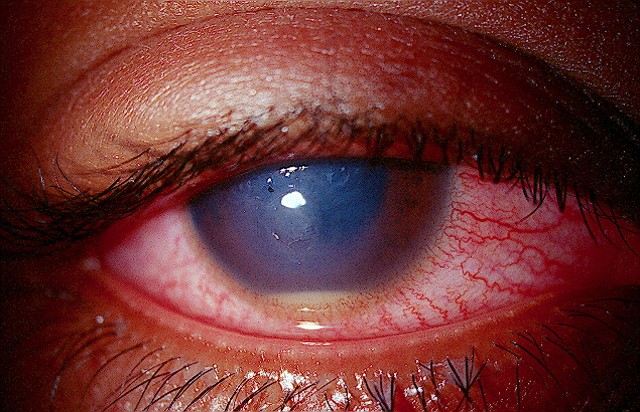 |
| The lower rate of endophthalmitis seen in the IOL exchange group may reflect a greater percentage of eyes with an intact posterior capsule, such as with intracapsular IOL exchange. Photo: Joseph Sowka, OD. Click image to enlarge. |
Researchers wanted to elucidate potential trends in development of postoperative endophthalmitis in cataract patients who need a second surgery, as it is higher following procedures of primary intraocular lens (IOL) implantation than those involving cataract, glaucoma or the retina. To do so, authors of a recent study retrospectively looked at Medicare fee for service beneficiaries who underwent IOL exchange or secondary IOL implantation for preoperative aphakia over 11 years.
Rates of endophthalmitis were calculated overall and separately for initial IOL implantation vs. lens exchange, with subsets included for anterior or posterior vitrectomy. Included in the study were a total of 97,152 patients. Endophthalmitis rates at the 42-day period for secondary IOL implantation for aphakia were 0.35% overall, 0.31% when combined with posterior vitrectomy and 0.84% with anterior vitrectomy. These rates were for IOL exchange were 0.28%, 0.30% and 0.42%, respectively. After analysis of potential risk factors, it was determined that endophthalmitis rates increased when secondary IOL surgery was combined with anterior vitrectomy. Conversely, risk decreased when IOL exchange was performed compared with secondary IOL implantation for preoperative aphakia.
In the discussion section of their paper for Journal of Cataract & Refractive Surgery, the authors convey that their overall endophthalmitis rate of 0.31% is comparable to one Medicare analysis reporting a rate of 0.36% for secondary IOL surgery; however, it remained higher than their reported infection rates following retina (0.24%), glaucoma (0.16%), standard cataract (0.08%) and combined cataract surgeries (0.11%). Importantly, this prior investigation noted that many reoperation patients lacked an intact posterior capsule, which they believed may have been the cause of higher endophthalmitis rates.
While rates of posterior capsular rupture (PCR) were unable to be identified in the current study, the study authors do purport that the overall rate of concurrent vitrectomies for all secondary IOL surgeries suggest more than one-third of these cases likely experienced PCR with vitreous loss.
The highest rate of endophthalmitis seen in this study was with secondary IOL implantation for preoperative aphakia combined with anterior vitrectomy. The researchers explain that absence or loss of the posterior capsular barrier would explain this higher rate, as bacteria could be introduced into the anterior segment during operation with direct access to the vitreous or residual vitreous post-vitrectomy.
As a suggestion, the authors advise that the higher endophthalmitis rate with concurrent vitrectomy and secondary IOL implants for aphakia that have PCR “may be reasons to consider intraocular antibiotic prophylaxis in these eyes. However, the proper dose is uncertain, considering the much larger aqueous compartment in eyes following PCR and vitrectomy.”
| Click here for journal source. |
Kerrison CH, Chang DF, Dun C, Sabharwal J, Woreta FA. Endophthalmitis rates following secondary intraocular lens surgeries: an 11-year Medicare fee-for-service analysis. J Cataract Refract Surg. October 9, 2024. [Epub ahead of print]. |

